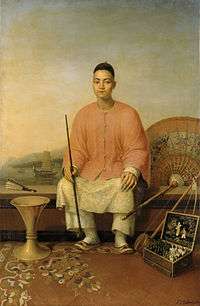Tangzhuang
| Tangzhuang | |||||||||
 Asia-Pacific leaders wearing tangzhuang at the 2001 APEC summit | |||||||||
| Traditional Chinese | 唐裝 | ||||||||
|---|---|---|---|---|---|---|---|---|---|
| Simplified Chinese | 唐装 | ||||||||
| Literal meaning | Han outfit | ||||||||
| |||||||||
| Other names | |||||||||
| New tangzhuang | |||||||||
|---|---|---|---|---|---|---|---|---|---|
| Traditional Chinese | 新唐裝 | ||||||||
| Simplified Chinese | 新唐装 | ||||||||
| Literal meaning | new Han outfit | ||||||||
| |||||||||
| APEC jacket | |||||||||
| Traditional Chinese | APEC服裝 | ||||||||
| Simplified Chinese | APEC服装 | ||||||||
| Literal meaning | APEC-style clothing | ||||||||
| |||||||||
A tangzhuang is a kind of pseudo-traditional Chinese jacket with a straight collar. It is an updated form of the Qing magua, itself a more fashionable adaptation of the riding jacket once worn by Manchu horsemen.
Name
Tángzhuāng is the pinyin romanization of the Mandarin pronunciation of the clothes' Chinese name, written as 唐裝 in traditional characters and as 唐装 in the simplified characters now used in mainland China. Its spelling may vary a little in other romanizations or dialects. It is also sometimes translated as a tang suit[1] or jacket.[2]
Although the name of the jacket in English and Chinese suggests an origin during (or at least reference to) the Tang period of Chinese history,[3] it was actually intended by its designers to mean a "Chinese" outfit.[4][5] In southern China and among the Chinese diaspora, dialects like Cantonese refer to ethnic Chinese—as opposed to all Chinese nationals—as "Tang people" rather than "Han". It is thus also sometimes translated as a Chinese jacket.[6][7] After criticism of the misleading name appeared in various Chinese media, some of its designers and some government officials began to call the garment the "new tangzhuang"[4][5] or "APEC jackets",[8][9] but neither name lasted.[10] Instead, most Chinese people came to accept the designers' original name for the garment and some even expanded it to describe any form of traditional Chinese clothing.[10]
History
Magua
The tangzhuang is an adaption[1] of the Manchu "horse jacket" (magua),[11] a waist-[12] or three-quarter-length[11] front-opening jacket[12] or surcoat.[11] This was initially worn—usually in a dark blue color—by Manchu horsemen,[12] but became mandatory for Han officials' clothing under the Qing Empire.[11] Over time, it evolved from a protective apron for the changshan into an item of Chinese fashion in its own right and even a mark of imperial favor. Its use then spread among the common Han,[11] including among the Chinese diaspora abroad.[1]
Following the 1911 Xinhai Revolution and 1949 Communist victory in the Chinese Civil War, the "Mao suit" (Zhōngshān zhuāng) gradually displaced the changshan and magua in most contexts. After the fall of the Gang of Four in the late 1970s and the beginning of Deng Xiaoping's Opening Up Policy in the 1980s, traditional clothing began to experience a revival in mainland China. Variants of the magua became noticeably more common in Chinese fashion from the mid-1990s.[2]
2001 APEC Summit
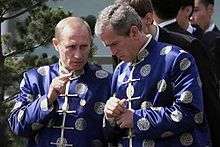
In 1993, US president Bill Clinton tried to bring trade talks back on track by inviting the heads of the APEC member economies to personally attend what had until then been a ministerial conference. He requested leaders' clothes remain informal and presented each with a leather bomber jacket bearing the APEC logo as a memento. The next year, Indonesia followed suit and presented batik shirts; the world leaders then humored Suharto's request that they wear them for a group photo.[13] The tradition developed that the summits' hosts would present traditional and representative clothes from their cultures,[14] and the leaders would wear them on the last day of the conference as a show of solidarity.[15]
Ahead of the first occasion of China's hosting the summit in 2001, state-run media acquainted the Chinese with the custom, prompting speculation as to what China's "traditional clothes" might be:[15] Mao suits had been displaced by western-style suits; minority groups often had recognizable ethnic costumes but styles of Han clothing (hànfú) had varied from dynasty to dynasty, with the most recent Qing forms heavily influenced by the Manchus and their oppressive dress codes. Although these designs were among the 40[16] presented to the Chinese government over the span of a year,[17] their foreign origin or political connotations[18] led officials to select an "ambiguously traditional"[15] design by Shanghainese clothiers Li Jianqin[19] (李建秦, Lǐ Jiànqín) and Yu Ying[20] (t 余鶯, s 余莺, Yú Yīng) and by five others at Qinyi (t 秦藝服飾, s 秦艺服饰, Qínyì Fúshì)[21] and the Shanghai Garment Group (t 上海服裝集團, s 上海服装集团, Shànghǎi Fúzhuāng Jítuán).[16][22][23]
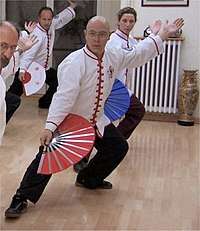
The jackets given to the APEC leaders were a blend of Chinese motifs and western design, made from silk supposedly artificially enhanced to be stronger, softer, more wrinkle-resistant, more water-absorbent, and better ventilated, with longer-lasting and brighter colors.[24] They featured cotton knotwork instead of buttons and a design of peonies surrounding the letters "APEC".[16] The jackets were handmade[17] but not personally sized; instead, they were fitted using stand-ins and body doubles,[25] with a partially-completed backup available in case those measurements were mistaken.[26] The leaders had a choice among scarlet, azure, green, brown, maroon,[17] and black versions;[16][26] each came in a matching silk bag adorned with the APEC logo[7] and each had an off-white[26] silk shirt to wear beneath it.[16] The 20 attendees—the leaders of all the APEC member economies except "Chinese Taipei"—mostly opted for the red-and-black[20] or blue-and-gold design[26] and wore the jackets to their meetings at the Shanghai Science and Technology Museum on 21 October 2001 and for the "Leaders' Family Portrait" afterwards that closed the event.[9][16]
Tangzhuang craze
The tangzhuang's use as the representative unisex Chinese clothing for the "Leaders' Family Portrait" immediately[27] led to its more widespread popularity,[2][28][29] spreading from Beijing to other large towns around the country as far afield as Lanzhou in Gansu by the next Chinese New Year.[8] This "tangzhuang craze" (t 唐裝熱, s 唐装热, tángzhuāng rè)[9] saw the tangzhuang and other traditional clothes become fashionable daily wear for both sexes, which gave a large boost to the domestic silk industry.[30] The original designers left their original companies to start their own businesses to capitalize on their creation's popularity,[10] but the fad was short-lived[31] and most had moved on by 2004.[10]
Subsequent history
_(2).jpg)
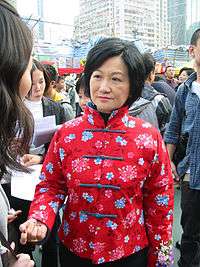
Even after the end of its fad, the tangzhuang continues to have a place in Chinese fashion. It remained in common use among Jiang Zemin's clique and the nouveau riche,[32] but more especially became a menswear staple on the mainland and abroad for traditional Chinese holidays[31][33] alongside western and Mao-style suits.[1][29]
The tangzhuang—and its fundamental inauthenticity as ethnic clothing—is also credited by members of the hanfu movement with having inspired their cause and a revival of actual traditional Han clothing, despite the Chinese public's usual confusion about its origin.[34][35] (Traditional Chinese fashions have been so long mixed with Manchu and western elements that Tang-style robes are confused with Japanese kimonos and Ming clothes with Korean hanboks.)[34][35]
China used the "Tang suit jackets" again for its 2014 APEC summit, but with an updated style in maroon, green, and blue that The Guardian unflatteringly compared to Star Trek uniforms.[36]
Style
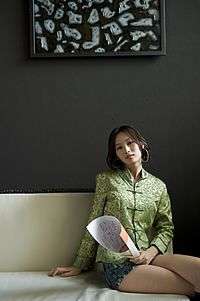
The APEC jackets were intended to reflect "both traditional Chinese flavor and modern ideals".[9][17] They have straight Mandarin collars,[1] similar to those on the changshan and magua that gave the style its name. Unlike the traditional 2D "flat-cutting" (平面裁剪, píngmiàn cáijiǎn) process used to create those garments, which tends to produce a baggy and ill-fitted look,[25] tangzhuangs are made using the 3D "solid-cutting" (t 立體裁剪, s 立体裁剪, lìtǐ cáijiǎn) process developed in Europe.[25] In particular, they employ draping, darts, and set-in sleeves cut separately from the rest of the main garment,[25] which give them a more fitted look than traditional Chinese designs.[37][24] The original version also employed shoulder pads to give a stronger silhouette.[24]
Although the APEC jackets were pointedly made using artificial fibers,[24] silk tangzhuang have since outsold those made from cotton and other materials.[30] Tangzhuang are available in a variety of colors, although the most common are red or blue.[27][8] The brocade is often decorated with a repeated pattern of embroidery.[1] Common designs involve the repetition of auspicious Chinese characters such as fú (福, "happiness") or shòu (t 壽, s 寿, "longevity") for good luck and good wishes.[27] Tangzhuang are usually fastened with decorative knotwork instead of buttons.[1]
Tangzhuang are usually considered menswear[38] but they may also be worn by women, as by New Zealand's prime minister Helen Clark at APEC 2001.[2]
See also
- Chinese clothing
- Hanfu, also meaning "Han clothing"
- Chinese button knot
- Color in Chinese culture
References
Citations
- 1 2 3 4 5 6 7 Butcher (2017).
- 1 2 3 4 China Daily (8 Feb 2002).
- ↑ Eller (2016), p. 1.
- 1 2 Zhao (2008), p. 58.
- 1 2 Zhao (2013), p. 77.
- ↑ McMillan (2001).
- 1 2 Finnane (2008), p. 285.
- 1 2 3 China Daily (13 Feb 2002).
- 1 2 3 4 Zhao (2008), p. 57.
- 1 2 3 4 Zhao (2013), p. 78.
- 1 2 3 4 5 Rhoads (2000), p. 61.
- 1 2 3 Dickinson & al. (1990), p. 116.
- ↑ Taylor (2014).
- ↑ Zhao (2013), p. 70.
- 1 2 3 Zhao (2013), p. 71.
- 1 2 3 4 5 6 People's Daily (21 Oct 2001).
- 1 2 3 4 Sina (21 Oct 2001).
- ↑ Zhao (2013), p. 72.
- ↑ TRWK (2017).
- 1 2 Qiao (2009).
- ↑ iDEALShanghai (2017).
- ↑ Shanghai Garment Group (17 July 2016).
- ↑ Dev. Report (2002), p. 194.
- 1 2 3 4 Zhao (2013), p. 75.
- 1 2 3 4 Zhao (2008), p. 78.
- 1 2 3 4 CIIC (23 Oct 2001).
- 1 2 3 People's Daily (25 Oct 2001).
- ↑ Lin (2010), p. 264–5.
- 1 2 Hew (2013), p. 196.
- 1 2 Zhang (2003).
- 1 2 Eller (2016), p. 2.
- ↑ Lin (2010), p. 124.
- ↑ Zhao (2013), p. 82.
- 1 2 Carrico (2017).
- 1 2 Wong (2006).
- ↑ Guardian (2016).
- ↑ Zhao (2008), p. 79.
- ↑ Bailey (2012), p. 169.
Sources
- "Traditional Dresses Welcome Spring Festival", China Daily, Beijing: China Daily Information Co., 8 Feb 2002 .
- "Chinese New Year Reinforces Return to Fashion of 'APEC Jackets'", China Daily, Beijing: China Daily Information Co., 13 Feb 2002 .
- "Leaders' Casual Attire for APEC 2001", Official site, Beijing: China Internet Information Center, 23 Oct 2001 .
- 中国纺织工业发展报告: 2001/2002 [Zhōngguó Fǎngzhī Gōngyè Fāzhǎn Bàogào: 2001/2002, China Textile Industry Development Report: 2001–2002], Zhongguo Fangzhi Chubanshe, 2002 . (in Chinese)
- "Awkward APEC Fashion: What World Leaders Wore–In Pictures", The Guardian, London: Guardian News & Media, 20 Nov 2016 .
- "Qin Yi", iDEALShanghai, Shanghai: Shanghai United Media Group, archived from the original on 21 November 2017, retrieved 8 Jan 2018 .
- "APEC Economic Leaders in Chinese-Style Costumes", People's Daily, Beijing: Central Committee of the CCP, 21 Oct 2001 .
- "APEC Leaders Dress to Impress", People's Daily, Beijing: Central Committee of the CCP, 25 Oct 2001 .
- "上海服装(集团)有限公司 [Shànghǎi Fúzhuāng (Jítuán) Yǒuxiàn Gōngsī, Shanghai Garment (Group) Ltd.]", Official site, Shanghai: Shanghai Garment Group, 17 July 2016 . (in Chinese)
- "章启月:领导人服装表达中国人民对APEC的期望 [Zhāng Qǐyuè: Lǐngdǎorén Fúzhuāng Biǎodá Zhōngguó Rénmín duì APEC de Qīwàng, Zhang Qiyue: The Leaders' Clothing Represents the Chinese People's Hopes for APEC]", Official site, Beijing: Sina Corporation . (in Chinese)
- "Shanghai Qinyi Fashion Co. Ltd.", 世界服装鞋帽网 [Shìjiè Fúzhuāng Xiémào Wǎng, World Clothing, Footwear, and Hat Network], Taiyuan: Taiyuan Ren'ao Wangluo Keji, retrieved 8 Jan 2018 .
- Bailey, Paul J. (2012), Women and Gender in Twentieth-Century China, New York: Palgrave Macmillan .
- Butcher, Asa (18 Apr 2017), "The Tang Suit and Its Qing Dynasty Origins", GB Times .
- Carrico, Kevin (29 Aug 2017), "Young People in China Have Started a Fashion Movement Built around Nationalism and Racial Purity", Quartz, New York: Atlantic Media .
- Dickinson, Gary; et al. (1990), Imperial Wardrobe, Bamboo .
- Eller, Jack David (2016), Cultural Anthropology: Global Forces, Local Lives, 3rd ed., Abingdon: Routledge .
- Finnane, Antonia (2008), Changing Clothes in China: Fashion, History, Nation, New York: Columbia University Press .
- Hew Wai-weng (2013), "Expressing Chineseness, Marketing Islam: The Hybrid Performance of Chinese Muslim Preachers", Chinese Indonesians Reassessed: History, Religion, and Belonging, Abingdon: Routledge, pp. 178–199 .
- Lin Xiaoping (2010), Children of Marx and Coca-Cola: Chinese Avant-Garde Art and Independent Cinema, Critical Interventions, Honolulu: University of Hawaii Press .
- McMillan, Alex Frew (21 Oct 2001), "'Shanghai Accord' Sets APEC Trade Agenda", CNN, New York: Time Warner .
- Qiao Hong (September 2009), "Chinese Clothing: From Gray-Blue to Coloured Years", Confucius Institute Magazine, Vol. 4, No. 4, Beijing: Office of the Chinese Language Council International .
- Rhoads, Edward J.M. (2000), Han and Manchus: Ethnic Relations and Political Power in Late Qing and Early Republican China, 1861–1928, Studies on Ethnic Groups in China, Seattle: University of Washington Press .
- Taylor, Adam (10 Nov 2014), "APEC's Silly Shirts: The Awkward Tradition That Won't Go Away", The Washington Post, Washington .
- Wong, Stephen (26 Aug 2006), "Han Follow Suit in Cultural Renaissance", Asia Times, Hong Kong: Asia Times Online .
- Zhang Wenjie (26 Nov 2003), "China's Silk Industry: A 'New Silk Road' to the International Market", CCTV, Beijing: SAPPRFT .
- Zhao, Andrew Jianhua (2008), Fashioning Change: The Cultural Economy of Clothing in Contemporary China (PDF), Pittsburgh: University of Pittsburgh .
- Zhao, Andrew Jianhua (2013), "Designing a National Style: The Tangzhuang Phenomenon", The Chinese Fashion Industry: An Ethnographic Approach, London: Bloomsbury, pp. 69–82 .
External links
- 《唐装》, 《上海秦艺服饰有限公司》, & 《上海服装集团有限公司》 at Baidu Baike (in Chinese)
